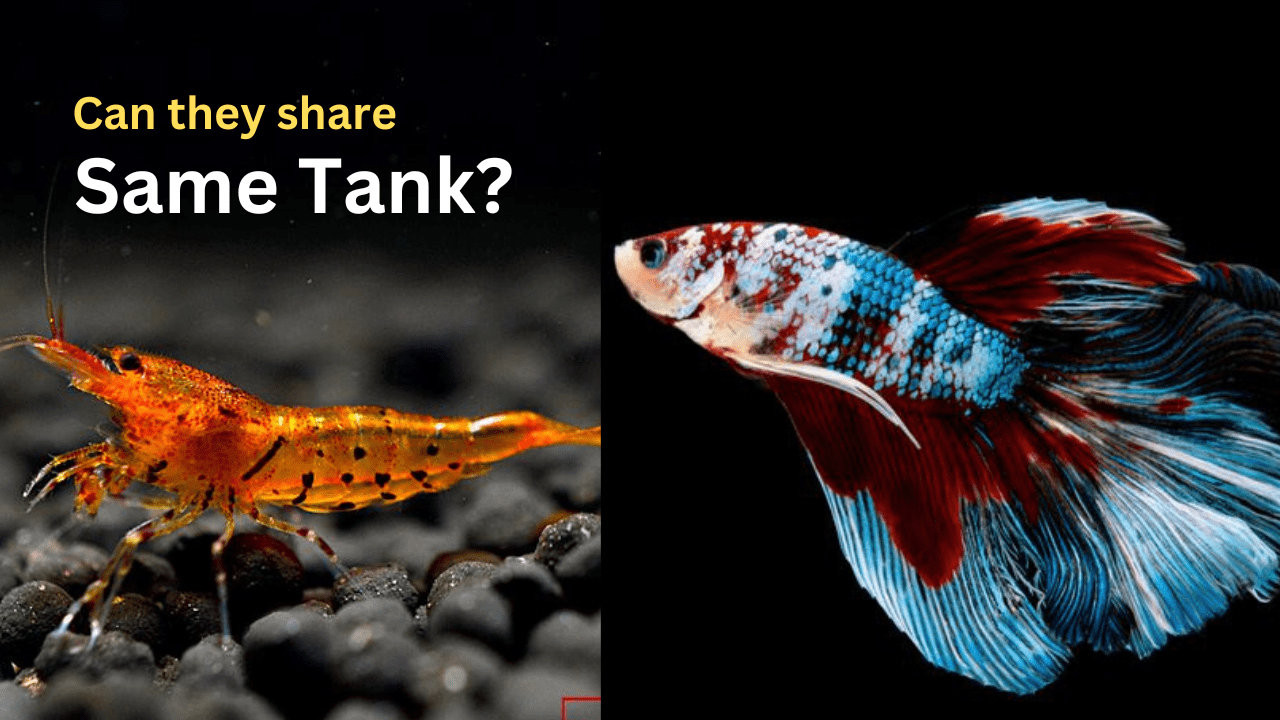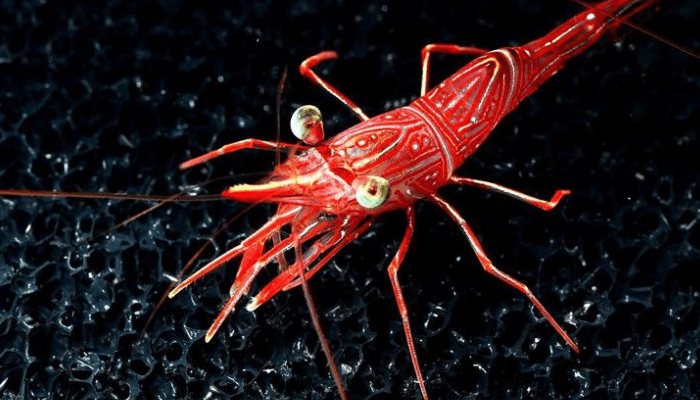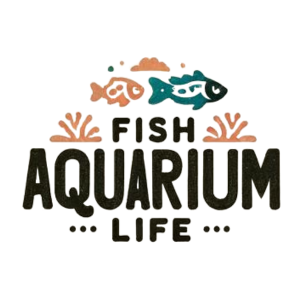If you’re planning a small aquarium, you might consider pairing two species suited for nano tanks: shrimp and Betta fish, also known as Siamese fighting fish. Both species are small in size, making them ideal for planted and lightly filtered nano tanks.
However, the question remains—can these two species live together harmoniously?
Fortunately, shrimp and betta share similar water requirements, simplifying the process of maintaining the tank. However, shrimp have unique needs to stay happy and healthy. Let’s explore what shrimp require and how to ensure they thrive alongside your betta, making this pairing a success.

Can cherry shrimp and Betta fish live together?
Bettas, being carnivorous, pose a potential threat to cherry shrimp. However, cherry shrimp’s rapid breeding and their larger adult size can sometimes allow them to maintain a population even in the presence of a betta. While some bettas may only occasionally prey on young shrimp, others may exhibit significant aggression towards them.
Therefore, successful cohabitation depends heavily on the individual betta’s temperament, and the possibility of shrimp predation should always be considered. Superficial observation might suggest that Betta fish and shrimp can coexist harmoniously
Key Considerations for Keeping Betta Fish with Shrimp
The fortunate reality for those considering a community of shrimp alongside a Betta fish is the relatively undemanding nature of shrimp care. Their well-being hinges upon a pristine, thriving environment and an appropriate nutritional regimen – a straightforward formula. Notably, these requisites mirror those of the Betta fish, thus streamlining the establishment of a suitable habitat for both species.
Thankfully, cherry shrimp are not particularly demanding in their care.
1.Tank size
For optimal shrimp health, a minimum tank volume of 10 gallons is recommended. However, when considering a community with a Betta fish, a larger tank size within the range of 15-20 gallons is ideal.
2.Water quality and filtration
Maintaining pristine water quality is paramount for shrimp well-being, as they are highly susceptible to pollutants and toxins. The incorporation of a filtration system is crucial for ensuring a healthy and parasite-free environment for these delicate creatures.
3.Ideal Temperature
The ideal temperature for shrimp lies between 20-24°C (68-75°F), a range that also aligns with the thermal preferences of Betta fish.
4.pH level
The optimal water pH for cherry shrimp and betta fish is remarkably similar. Both thrive in slightly acidic conditions, with an ideal pH range between 6.5 and 7.0. This shared preference for water chemistry simplifies tank maintenance and ensures a comfortable environment for both species.
5.Dietary Requirements
The dietary requirements of shrimp are diverse, encompassing a range of commercially available shrimp-specific foods, alongside supplementary offerings of fresh vegetables and algae. Moreover, they readily consume any residual fish food that remains unconsumed within the aquarium environment.
What Shrimp Can Live With Betta?
This section offers a brief summary of the shrimp species commonly housed alongside Betta fish. To ensure their well-being, it’s important to keep shrimp in small groups of 6-8 or more, as this helps maintain their happiness and natural behavior.
1.Ghost Shrimp with Betta

Ghost shrimp, or Palaemonetes paludosus, are fascinating miniature shrimp species native to North America. Their ghostly appearance, often earning them the nickname “glass shrimp,” makes them an intriguing addition to any community tank. They thrive in still or slow-moving waters, seeking oxygen by brushing their antennae against aquatic vegetation. Known for their docile and kind nature, they generally coexist peacefully with Betta fish in well-maintained environments.
These scavengers feed on a wide range of foods, including live plants, algae wafers, sinking pellets, and frozen foods. They even consume small insects and detritus found in the substrate. Their clever camouflage helps them blend into their surroundings, making them less visible to predators, including aggressive Bettas. However, it’s crucial to choose ghost shrimp that are fully grown, reaching up to 1.5 inches, as smaller ones (under 1 cm) may be mistaken for prey.
2.Amano Shrimp with Betta

Amano shrimp (Caridina multidentata) are a popular freshwater shrimp species native to Asia, named after the renowned Japanese aquarist Takashi Amano, who founded the famous aquascaping brand ADA. These shrimp have gained popularity among aquarium enthusiasts, including Betta fish owners, for their peaceful nature and practical benefits.
In the wild, Amano shrimp tend to congregate in groups, scavenging through streambeds and agricultural land. In an aquarium, they are excellent at removing debris, consuming everything from uneaten fish food to decaying matter in the substrate. They can coexist peacefully with Betta fish and other tank mates if the aquarium has ample vegetation, as they love hiding among plants. These characteristics make them invaluable for maintaining a clean and balanced environment.
3.Cherry Shrimp With Betta

Keeping Cherry Shrimp (also known as Neocaridina davidi) with Betta fish can be a rewarding experience if done thoughtfully. These fascinating creatures are a resilient species, originally native to China and Taiwan, but now introduced to many other countries. Their eye-catching pink hue, along with shades like orange, yellow, green, blue, violet, red, and black, make them an aesthetic addition to any community tank. Cherry shrimps are hardy and thrive in the peaceful nature of an aquarium, which is why they are ideal for beginner aquarists.
However, pairing them with a Betta fish requires caution. While Cherry shrimps are known to stay out of the way, their fast jerky movements can sometimes trigger aggression in a Betta. Additionally, the size difference might make them appear as prey, especially if the Betta has an aggressive personality. To ensure harmony, provide plenty of plants and hiding spaces. Their diet is another key consideration; Cherry shrimps feed on algae, decaying organic matter, and can enjoy commercial food pellets, blanched vegetables, and even frozen foods like bloodworms. Together, they can create a vibrant and balanced freshwater tank if the environment is properly managed.
Tidbit: Cherry shrimp offer stunning variations like Red Cherry Shrimp (RCS), Sakura Red, Red Fire, and Bloody Mary. These popular choices bring vibrant hues and are perfect for enhancing a community tank, making them a favorite among both beginner aquarists and enthusiasts
Shrimp Species to Keep Away from Bettas
After exploring the best freshwater shrimp species for Betta fish aquariums, it’s time to discuss which ones might not be ideal.
1.Camel Shrimp

Camel shrimp (Rhynchocinetes uritai), often called camelback or dancing shrimp, are small shrimp, typically measuring 1 to 2 inches. Found mainly in Asia and Australia, they thrive in saltwater, making them unsuitable for freshwater tanks with Bettas.
Although their beauty is undeniable, Camel shrimp require a dedicated shrimp-only saltwater aquarium to survive, as they cannot live in freshwater environments.
2.Bee Shrimp

Bee shrimp (Caridina cf. cantonensis) are highly sought after in the aquarium industry, known for their captivating alternating pattern of vibrant colored stripes and neutral bands. These active and playful shrimp add beauty to any setup, making them a favorite among aquarists.
However, their gorgeous colors and small size make them unsuitable for a Betta tank. Bettas, being territorial and wary of brightly colored creatures, might mistake bee shrimp for food, leading to potential conflict.
3.Bamboo Shrimp

Bamboo shrimp (Atyopsis spinipes) are stunning freshwater creatures that bring a touch of life and vibrancy to any aquarium. Known for their wood grain pattern, they blend seamlessly into their surroundings, which inspired their name. With a stockier and broader structure, they stand out compared to slimmer shrimp species.
Despite their natural beauty, Bamboo shrimp are unsuitable as tankmates for Betta fish. They require abundant algae to thrive and may compete with Bettas for food, making coexistence challenging.
Before Adding Shrimp to a Betta Tank
When planning to add shrimp to a Betta tank, be mindful of several essential aspects.
1.Ensuring Safety Based on Shrimp Size
Bettas are naturally territorial and aggressive, driven by their instincts as predators. They tend to prey on lesser species, and smaller shrimp often become targets in a shared tank. If the shrimp can fit in a betta’s mouth, it is likely to be injured, killed, or even devoured. To prevent this, avoid introducing fragile shrimp that might be seen as a snack and instead select larger, robust species that can coexist more safely.
2.Shrimp Species
When adding shrimp to your freshwater aquarium, it’s essential to make choosing the right species a top priority. Not all shrimp species can peacefully coexist with a Betta fish, as their natural instincts can lead to territorial disputes. My experience has shown that focusing on calm and compatible species makes all the difference in creating harmony in the tank. By paying attention to the details outlined below, you can ensure a safe and stress-free environment for both your Betta and the shrimp.
3.Tank Compatibility
When purchasing a species of shrimp, ensure their optimal tank parameters overlap with those of your bettas to maintain a balanced and stress-free environment. Avoid selecting shrimp that need significant alterations to your aquarium, as such changes can disrupt the harmony required for both to thrive. A well-planned shared environment will keep the tank healthy and visually appealing while meeting the needs of all inhabitants.
4.Aquarium Decor
Shrimp are naturally active yet timid, so it’s crucial to include plenty of hiding places in your tank. Rocks, driftwood, plants, and shrimp-safe decorations can all help provide secure areas for shrimp to hide if they feel threatened or stressed. During their molting season, which happens once a month when they shed their outer skin and grow a new shell, these hiding spots become essential. This safe environment allows the shrimp to escape and remain calm while their shell hardens, reducing anxiety during this sensitive time.
Will Bettas Eat Shrimp?
Bettas are carnivorous, often attempting to eat any small creature they encounter, including shrimp, as their digestive system efficiently processes small crustaceans. A hungry Betta will likely target shrimp, but this doesn’t rule out cohabitation in the same tank.
When Bettas are fed well and on time, they may completely ignore shrimp, especially in tanks with abundant hiding places and plants to offer cover. This balance ensures a peaceful coexistence for both species.
How to Protect Your Shrimp in a Betta Tank
Planning to introduce shrimp to your Betta tank? Follow these tips to help them thrive and stay safe.
1.Introducing Shrimp Safely
When setting up a Betta tank with shrimp, always introduce the shrimp first. This allows them to establish themselves in the aquarium, getting familiar with their new environment and finding hiding spots in plants or rocks. By doing this, the shrimp have a chance to settle before the Betta fish arrives.
Since Bettas are highly territorial, adding them first can cause them to see the shrimp as intruders, leading to aggression. Prioritizing the shrimp’s introduction helps reduce conflict and promotes a balanced tank.
2.Provide Adequate Tank Space
A large tank ensures that both your Betta and shrimp have ample space, preventing them from feeling overcrowded. This reduces the chances of confrontations, allowing them to coexist peacefully. An ideal tank size is about 10 gallons, but opting for a larger tank is always beneficial for their well-being.
3.Ensure Hiding Spots for Shrimp
Creating abundant hiding spots is crucial for keeping your shrimp safe in a Betta tank. In a planted tank, adding driftwood, rocks, and live plants offers a secure haven for shrimp, protecting them from any potential predatory behavior by the Betta. Additionally, these plants and hiding places help your Betta feel more relaxed, reducing the likelihood of aggression toward their tankmates.
4.Keep Your Betta Entertained
Bettas are intelligent fish that can get bored without proper stimulation, which might lead them to attack their shrimp companions. By offering plenty of enrichment activities, you can keep your Betta engaged and less likely to target the shrimp in their tank.
FAQs
How many shrimp can live with a betta?
In a shrimp-only tank, caring for dozens of shrimp is simple, even with just 5-10 gallons of water. However, in a community tank, the rules change. A general guideline is to house 1-2 shrimp per 1 gallon of water. The number can vary based on shrimp size, as smaller shrimp can be kept in larger numbers without issue.
How fast do cherry shrimp breed?
Shrimp typically start breeding after 3-5 months, with females being most receptive to males’ advances right after molting.
How big are ghost shrimp?
Shrimp are small, reaching only about 1.5 inches in length. Their delicate nature and size make them vulnerable, as many fish may nibble on their legs or antennae, or even swallow them whole if the fish is large enough.
How Long Does Shrimp Live?
Shrimp typically live for 1-6 years, depending on conditions. The most important factor in their lifespan is water quality, so ensure your tank provides clean, oxygen-rich water to keep your shrimp healthy.
Can Bamboo Shrimp Live with Bettas?
It’s not an ideal pairing. Bamboo shrimp rely on their delicate fans to feed, which may get nipped by a Betta fish, potentially hindering their ability to eat properly.
Can a Betta Fish Live with a Dwarf Crayfish?
Yes, this combination can work. As mentioned in the full post on Betta fish and dwarf crayfish compatibility, they can coexist under the right conditions.
Conclusion:
Shrimp and Bettas can coexist successfully if you follow the key tips. Provide a larger tank, ample hiding places, and maintain an ammonia-free environment to ensure their well-being.
Additionally, keep your Betta entertained and offer your shrimp a balanced diet. With these measures in place, both can thrive and live together in harmony.
